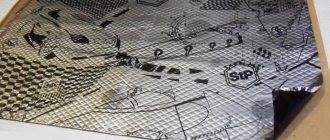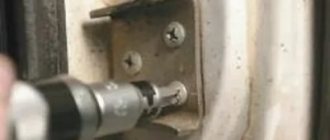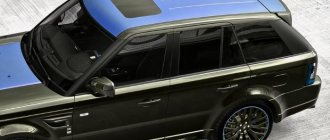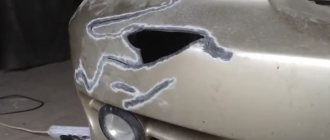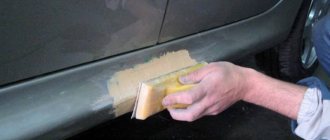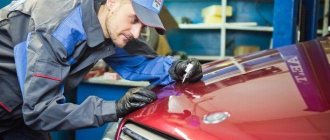Hammer paint roller
Hammer paint or, as it is also called, blacksmith paint got its name because of its appearance after drying.
The effect was as if the object had been hit with a heavy hammer. It interacts well with the external environment due to the high density of the substance. Anti-corrosion and moisture-repellent. There are several ways to apply enamel to the surface, but the easiest way is to use a roller. So, where is blacksmith's paint used? All Car History Volume 14 Hyundai is the world'
Hammerite paint and features of its application
The most famous product on the market is hammer paint under the Hammerite brand, produced in Germany. Yes, it is not cheap at all, but its technical characteristics are so high that this is a strong catalyst for demand. However, in order for these same characteristics to take place, it is necessary to adhere to several rules for applying the composition:
- You should work in a temperature range of 10-25 degrees Celsius. In this case, the maximum humidity should not exceed 85 percent. Hammerite cannot be used in foggy or rainy weather;
- If it is necessary to achieve the strongest hammer effect, it is better to apply the paint in five layers, each of which is applied eight hours after the previous one. Thus, the work may take quite a long time, but the result will be excellent;
- This paint takes a fairly short time to dry - an hour and a half. However, it takes approximately two weeks for the composition to achieve full strength and set all technical characteristics.
Scope of application of hammer paint
This type of material is used when applied to a metal plane. This is possible thanks to its properties:
- resistance to temperature changes;
- applying paint without preparing surfaces with rust;
- quick drying;
- protection for metal from corrosion and water;
- high strength;
- absence of harmful fumes;
- does not burn out.
The surface looks neat and clean even during precipitation, due to its properties.
Important: Removing hammer paint from an object is difficult.
Traditional use: forged and cast iron products. Today, the use of blacksmith's paint has expanded:
- gates and fences;
- building metal structures;
- parts of mechanisms and machines;
- garden and interior furniture;
- decorative elements.
The substance is applied not only to metal. Suitable for use on materials made of glass, plastic, ceramics and wood.
It is advisable to paint on a horizontal surface; it spreads on a vertical slope and the desired effect will be more difficult to achieve. If you cannot turn the object to be painted over, choose a quick-drying option.
Painting with hammer paint using a roller
There are several ways to apply hammer shade. The most common:
- With a brush. It is better to paint small areas. The hammer dissolves the brush bristles if they are not natural. You need to apply 2-3 layers.
- With a spray can or spray gun. Great for large areas. The most expensive way to paint an object. Apply in 3-4 layers.
- With a roller. You can paint smooth and fairly large surfaces. The length of the pile is 4-11 centimeters. The enamel itself spreads over the plane if the roller is chosen correctly.
Of the methods listed, the best one is a roller. It will save money when applied to the surface, and also has a fairly large area to work with. So, how to paint with a roller and hammer paint? Painting with a roller is not difficult, but there are some subtleties:
- The first layer of hammer substance is diluted 9 to 1 with solvent. Subsequent layers do not need to be thinned;
- a medium-sized roller is needed;
- the substance is applied to the corners, then the rest of the surface is painted;
- must be applied in several parts. If the layer is thin, bubbles may appear, and the protective properties become worse;
- the second comes after passing for at least half an hour;
- a third layer is applied if needed. The substance is applied in a thick coating to avoid sagging.
It is advisable to apply hammer paint with a roller to a horizontal surface. This will make it easier to apply a layer of paint, and the absence of streaks will be good news.
Types and features of hammer paint
Now the industry produces different types of hammer paint , so you can buy :
1. alkyd-styrene enamel, which can withstand temperatures up to 130 degrees in both directions from zero, dissolves only in xylene and is suitable for any type of work, for example - ML-165;
2. epoxy enamel for external work “2 in 1”, intended mainly for construction vehicles and street metal objects - lamps, gates and so on, it is applied to rust and perfectly masks chips, resistant to all weather conditions, dissolved with solvents No. 648 and No. 667, example - EP-1323 ME;
3. nitro enamel, intended for “home” use, that is, suitable for pieces of furniture and fragments of interior interiors, with pronounced decorativeness and lower technical properties in heat resistance, resistance to precipitation and other external influences, dissolves with conventional solvents for enamels, example - NC -221;
4. hammerite paint - English enamel, with very high technical and decorative properties, as well as complete versatility in use and the absence of a strong specific odor.
In addition, paint is divided into regular paint in cans and sprayable aerosols in cans.
Hammer paint has various release forms, which allows the consumer to choose the most convenient method of application.
How to paint with hammer paint correctly?
Painting with hammer paint does not require any special skills, tricks or techniques. Although “forging” is undemanding, some preparatory work is worth carrying out:
- if there is a layer of crumbling, swollen, crumbling old paint on the surface - oil, bitumen-containing or powder, then it needs to be cleaned off;
- new products must be degreased, completely cleaned of grease using any technical means, for example, white spirit, solvent and acetone;
- the surface must be freed from loose, falling rust and falling off layers of paint;
- for wooden surfaces or products you need a primer, water-based acrylic is ideal, this is necessary in order to get a decorative effect, without a primer the paint is simply absorbed into the wood;
- glass, plastic and other materials must be grease-free and clean.
The technologies and method of painting itself depend on what tool you plan to use:
1. Brush
You need to choose a brush carefully, checking before purchasing for convenience and for “shedding”, that is, buy with bristles that do not come out. This tool is irreplaceable for complex surfaces, with details or hard-to-reach places.
The painting itself should be carried out like this - two layers on horizontal surfaces and three on verticals. This will provide maximum decorative effect.
2. Roller
A tool ideal for large, flat surfaces, such as walls or countertops. It is necessary to purchase one made of velor or fur with short, medium-hard pile; the paint corrodes foam rollers.
The paint is applied in two or three layers. Depending on whether the work is carried out horizontally or vertically.
3. Aerosol can
Good for painting over defects, decorating complex ornate surfaces or individual elements, as well as when making artistic images on cars.
Apply 3-4 layers from a distance of 15 to 25 cm. Everything that cannot be painted must be securely covered. The first layer dries from 2 to 5 minutes, the subsequent ones from 20 to 30 minutes.
4. Pneumatic spray gun
Good at working over large areas with decorative elements, both protruding or convex, and sunken. Due to the fact that it is impossible to paint exactly any surface with a spray gun, a good additional enhancing decorative effect is created. Painting is carried out in 2-4 layers, making sure to thoroughly dry each of them.
5. Sprayer
Airless and air-powered sprayers are not the best choice for working with this paint as the enamel is very heavy. The use of this tool will require diluting and changing its density, which will inevitably lead to a loss of technical and decorative qualities.
The average consumption of material, if hammer paint is applied over rust and other complex surfaces, is from 100 to 150 grams per square meter.
Recommendations for performing work
Now many people know how to paint decorative items, furniture, and so on without referring to instructions, since they already have experience. But hammer paint is a completely different matter. It is suitable for application to rusty surfaces. Preparatory work before painting is not important. The substance will always perform well. The material is resistant to temperature changes and is considered quite easy to apply.
There are only a few preparatory steps to take into account:
- The metal plane is cleaned of factory grease. Afterwards it is sanded or treated with a wire brush;
- the old layer is cleaned of loose pieces, washed with water and powder and dried;
Important: Hammer is effective only on firmly adhering paint or rust:
- non-ferrous metals, stainless steel or aluminum are coated with a special primer before painting;
- the composition is absorbed into the wood. To prevent this from happening, the surface is treated with acrylic primer before doing this.
After preparation, the coloring solution is applied.
Important: It is advisable to apply to a horizontal surface to avoid drips on the surface.
The procedure for painting with hammer paint:
- Clean the coating thoroughly to remove dust, debris, and greasy marks.
- Stir until smooth. During long-term storage, sediment appears.
- You have to paint quickly. The enamel sets quickly.
- We wait 25-45 minutes and apply the second layer.
- Usually 2-3 layers are applied.
- The foam roller is corroded. Take a fur roller.
- It is better to paint vertical planes with a spray gun.
- Any actions with the item must be stopped for 24 hours. That's how long it takes for paint to dry.
- If humidity or temperature is high, do not work.
- Glossy surfaces are sanded to create roughness.
Compound. Main characteristics
To understand what hammer paint for metal is, let’s figure out what it consists of. Although the secret of its manufacture remains a secret, it is known for certain that the binder in it is alkyd-styrene resin and fatty acids. It also contains silicone and aluminum powder. An uneven film, similar to chasing, is formed due to the introduction of crushed glass. The addition of fine-grained oils, capable of covering even the smallest irregularities, significantly increases the protective properties.
Let us list the main characteristics of such compositions:
- do not have a pungent odor;
- absolutely safe and free of toxins;
- extremely durable, an impact may leave a dent on the metal, but not even a crack will appear on the paint; it even withstands vibration perfectly;
- are not afraid of temperature changes (withstands up to 80°C), sunlight, and do not fade;
- do not lose their protective properties for 8-10 years: you no longer have to paint the metal often;
- form a film that cannot become electrified, that is, dust and dirt do not stick to it; as a result, even white hammer paint remains clean during use;
- hide irregularities and flaws;
- can even be applied to a layer of rust;
- dry very quickly, within 2 hours (application of a second layer is recommended a little later, after 5 hours, when the film not only dries, but also gets stronger).
The disadvantages include considerable consumption of material (up to a liter per 9-10 sq. m). When painting, a little less hammer paint for metal in spray cans is used.
Unusuality
After drying, it again surprises with its unusual properties, unique to it.
Differences between hammer paint and regular and nitro enamels:
- does not require pre-treatment of the surface before painting;
- moisture and heat resistant;
- resistant to UV radiation, does not fade in the sun;
- painted surfaces are resistant to any detergents;
- simplicity of the painting process, accessible even to beginners;
- allows you to paint not only metal, but also any other material.
Let's take a closer look at these differences:
- Pre-treatment of painted surfaces.
It has been reduced to a minimum. The fact is that hammer paint includes the additional function of removing rust. This means there is no longer any need to spend time and effort cleaning off all the rust spots before painting. The paint itself is able to neutralize them.
Of course, if the rust peels off in pieces, then this place must be cleaned. Otherwise, the paint will hide it completely, but the corrosion process will continue. It’s not hard to guess where this will lead.
- Moisture and heat resistance.
It would be appropriate to include here also such an indicator as paint strength. The whole highlight is that the composition contains acrylic, alkyd-styrene and epoxy bases. In combination with aluminum powder and fine glass, all these components work truly miracles. The paint becomes more resistant to moisture and temperature changes.
The change in its properties begins at temperatures above 130ᵒ C. Thanks to increased adhesion (the ability to adhere to other materials), it adheres very firmly to the painted surface. For example, no one has ever been able to remove the bottom layer of paint during a renovation.
- UV resistance.
Ultraviolet rays destroy any enamel and paint, but not hammer paint. Thanks to its special properties, it does not fade in the sun. Color stays constant
Car enthusiasts pay special attention to this parameter. They are no less pleased with the fact that the paint is resistant to any detergents
- Possibility to paint any materials.
, concrete
On the one hand, the main determining factor in this case will be that the paint is more expensive than conventional enamels. And the hammer effect on such surfaces is less prominent, not at all the same as on iron.
On the other hand, painted products acquire reliable protection from any atmospheric phenomena for 8 years without changing their appearance.
The surface painted with this paint acquires a textured metallic sheen and a barely perceptible roughness. This is clearly visible in the photo. The color range of hammer paint is quite extensive. It is not difficult to choose any desired color.
Kinds. Color spectrum
These formulations are available in three varieties:
- NTs-221: relatively cheap compounds intended for indoor work; their protective properties are slightly lower; This hammer paint for metal has a lot of colors - there are about 2 dozen of them;
- ML-165: they can only be used to paint degreased surfaces; durable, heat-resistant, can easily withstand elevated temperatures, but when heated they can release a small amount of toxins; There are only three colors: golden, gray and black;
- Hammerite: the highest quality and most expensive; reliably protect the metal from oxidation, does not require priming, has the widest palette of shades, from khaki, copper, silver, gold to dark chocolate; but the most popular is black hammer paint.
Hammer paint application technology
| Device | Application | Tool selection | Application technology |
| Brush |
Advice! Experts recommend applying blacksmith paint with a roller rather than a spray gun. Using the latter, it is more difficult to achieve its uniform distribution over the surface.
Thus, knowing how to paint with hammer paint, you can get a reliable protective coating and an interesting decorative effect on almost any surface.
Hammer paint is a unique durable coating. Its original purpose is to paint equipment in production workshops and laboratories, machinery, and various structural elements operating in less than favorable conditions. Nowadays, the scope of application of the material has increased significantly, and now hammer paint for metal is used in a wide variety of places, including for interior decoration.
Application methods
Let us tell you in detail how to paint with hammer effect paint:
- Despite the fact that it can be applied even to a small layer of rust, grease, dust and dirt, it does not tolerate. Therefore, it is necessary to first thoroughly degrease the surface with acetone or white spirit.
- There is a simple way to check for fat. You should attach a piece of napkin or thin paper to the metal. If oily stains appear, the degreasing process should be repeated.
- Although the paint adheres perfectly to the surface, it is advisable to treat metal that is too smooth and shiny with sandpaper or a grinder. This will help increase adhesion.
- Old layers of other types of paint are removed. If they peel off over time, the painting process will be pointless. A small layer of rust can be left. You only need to get rid of large pieces and sagging.
- The surface must be perfectly dried.
- Only non-ferrous metals require priming. Ordinary steel does not need to be primed.
- This paint is applied as usual, with a brush or short-haired roller. When using a spray gun, the composition must be diluted a little thinner. Hammer paints are diluted with white spirit or special solvents.
- Work begins with corners and edges. They are processed most carefully. After all, rusting begins precisely from these places. Then the rest of the surface is painted.
- According to the instructions, hammer paints should be applied in several layers. There may be at least two or three, or even four.
- When using cans, shake them well to lift the sediment from the bottom. This dyeing method is considered the most effective. Using an aerosol, you can thoroughly treat even hard-to-reach places.
- Wooden surfaces can also be painted with such solutions. In this case, the composition must be diluted with thinner acrylic primer.
Thus, today hammer paint is one of the most effective methods of corrosion protection. It can even be applied to products that have previously been subject to corrosion, without removing the rust layer.
How to apply hammer paint
Before using hammer paint, you need to mix it well. The surface is cleaned of dirt and dust, old coatings, rust and oil stains. After this, the surface is primed with GF-021 or a similar primer. If the surface is too smooth, it should be sanded with fine sandpaper to a matte, slightly rough state.
The very first layer is applied very thinly. Moreover, hammer paint must be rubbed in with force. This will ensure that the paint will not crack or peel even under unfavorable operating conditions.
Subsequent layers of hammer paint are made thicker. Depending on the situation, up to three layers can be applied to the surface.
Hammer paint dries quickly. After 4 hours it will no longer stick and you can apply the next layer. The hammer paint dries completely within a day.
You can apply hammer paint using ordinary painting tools. A good choice would be a brush, roller or a special paint sprayer.
If there is a suspicion that the surface is not particularly suitable for applying hammer paint, it is recommended to do a test painting of a small fragment a day before.
The pattern and texture of hammer paint is adjusted during application. If you apply this type of paint with a spray or just a very thin layer, the pattern will turn out small. If hammer paint is applied to the surface in thick layers, the design will turn out large.
Hammer paint is an excellent choice when the task is to obtain not only a reliable coating that will protect the metal surface from adverse factors for many years, but also a beautiful coating that is attractive in appearance. The combination of reliability and decorativeness makes hammer paint an indispensable material in a number of cases.

